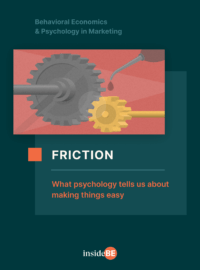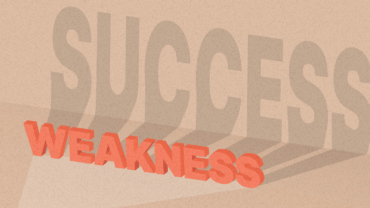9 Astonishing Examples of Social Proof

Social proof is one of the most widely used tools in a marketing toolkit, but it’s beginning to suffer from Banner Blindness Syndrome (BBS). How can you design it in a way that’s innovative?
Article content:
We’ve devised a highly informative, long-form article on social proof. So if you’re a BE rookie, we recommend starting there first. For all other readers eager to see some hands-on examples, be sure to keep reading below.
Defining social proof
When we’re uncertain of what to do, we look at others for clues on the right course of action to take. As a matter of fact, 82% of us are more likely to buy something simply because someone else close to us (be it a friend or a family member) recommended it.
Thar’s social proof – our innate tendency to be swayed by other people’s choices, especially when we find ourselves in ambiguous situations. We mirror other people’s actions because we believe they reflect “correct behavior.”

Discover ground-breaking ideas and fascinating solutions.
Like with any other bias, social proof is a shortcut – it saves us time and keeps us safe (when we “follow the pack” and group consensus, we’re less likely to be excluded), but it can also lead us to make poor decisions. Nowhere is social proof more used (and abused) than in marketing and sales.
5 types of social proof + examples
1. Case studies
A case study is essentially a data-driven report that delves deep into the product or service that you’ve already provided to existing customers. It’s a great way to showcase satisfied customers, provide relevant details about their experience with your business (while also alleviating uncertainty), and present the results. Definitely a good idea to use this if you’re marketing B2B software and agency or consultancy services.
How to go about it? Identify the clients you’ve had great success with and reach out to them to see if they’d be willing to participate in a case study– it’s crucial that they’re enthusiastic about participating. There are many different ways you can present your case studies, whether you choose to offer them as downloadable PDFs or host them directly on your blog.
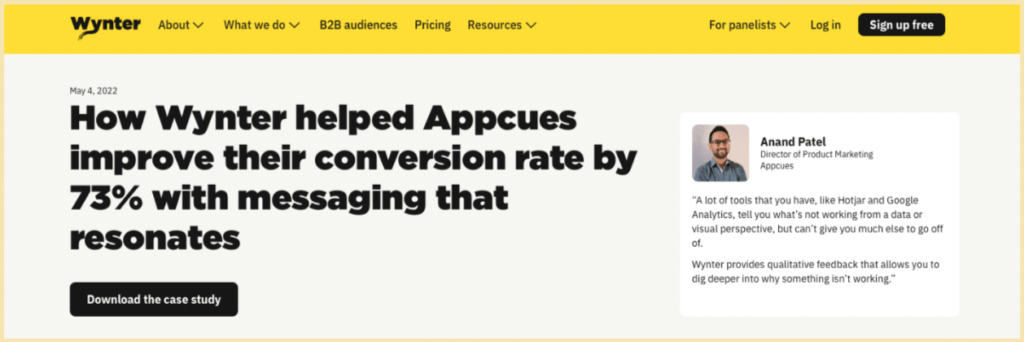
Source: Wynter
2. Testimonials
Wynter combines the case study with another powerful type of social proof – the testimonial. Testimonials are like pigeons on St. Mark’s Square in Venice; they’re everywhere and we’ll often do our best to ignore them. But there are some good rules of thumb to abide by so that these simple, short-form recommendations from happy current customers are as effective as possible.
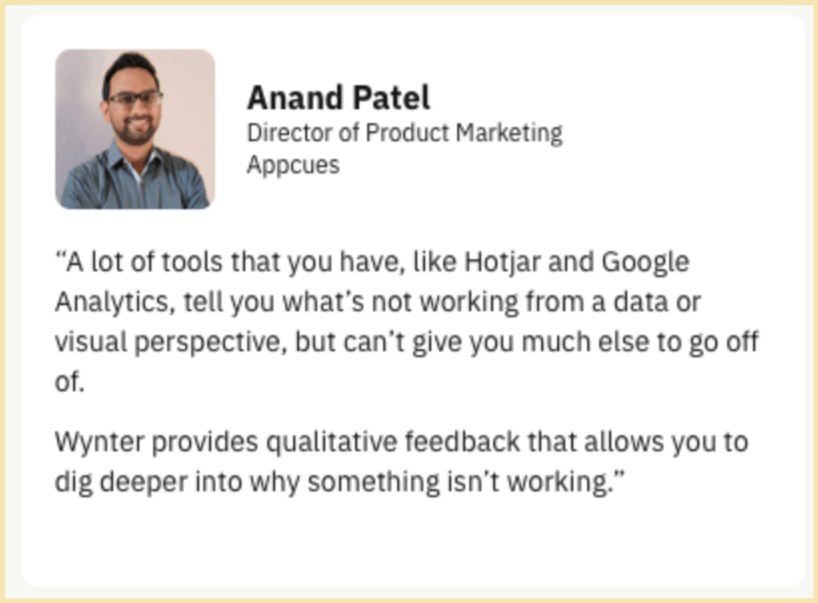
Source: Wynter
If you’ve got great testimonials, ideally from well-known authorities, use them. Always include a picture, name, company, and role. It’s a sure-fire way to legitimize your testimonials. Research shows that testimonials with photos are significantly more effective in generating viewer recall than testimonials with none whatsoever.
Research shows that testimonials with photos are significantly more effective in generating viewer recall than testimonials with none whatsoever.
Keep in mind that all testimonials draw in the customer’s attention, so if yours are mediocre, that might be all that visitors will remember about your page: mediocrity.
You can even take it a step further and use them in job ads to help alleviate potential uncertainties that applicants might have and to address their concerns. This type of ad, which applies social proof testimonials among other interventions, helped one job posting site increase its number of applicants by 200%.
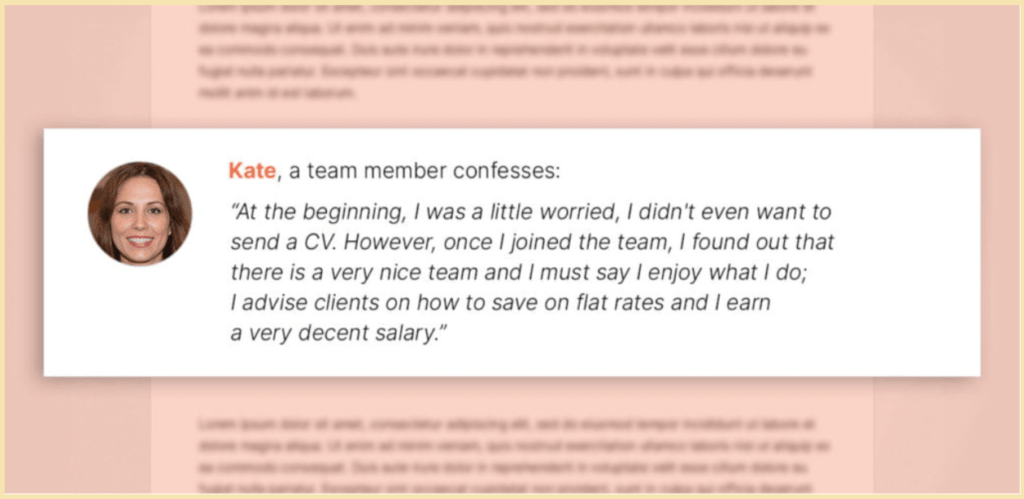
Source: InsideBE
3. Reviews
Customers appreciate transparency, openness, and honesty, which is why social proof in the form of reviews can help create a sense of community. CXL refers to them as “testimonials’ more objective cousins” and we couldn’t agree more. Reviews are great for tech products or highly competitive industries where they can help give a more competitive edge.
But as always, there’s a good way and a less convincing way to go about them. So how can you employ user reviews in a way that’s smart?
Let the blemishing effect do its job.
Your first impulse might be to show nothing less than five-star reviews. But the way the blemishing effect works is that a negative review that mentions a mild imperfection within the shuffle of positive reviews can actually make us want to purchase the item or service. One small, bad review will actually boost our overall positive perception of the product.
When something is portrayed solely as “fantastic”, “riveting”, or a “complete game-changer”, it makes it sound kind of gimmicky and makes us suspicious or more likely to look for reasons why it might actually be bad. We have no choice but to approach it with skepticism.
When something is portrayed solely as “fantastic”, “riveting”, or a “complete game-changer”, it makes it sound kind of gimmicky and makes us suspicious or more likely to look for reasons why it might actually be bad. We have no choice but to approach it with skepticism.
On the flip side, balanced arguments are more persuasive. No solution is right for everyone, and you know it. if you don’t show this in your reviews, people are less likely to believe you. Talking about your weaknesses can actually help your case. One example is how Reebok will tend to feature an overall positive review without shying away from negative ones either.
The only one-star rating for their sneakers is a customer’s personal problem: “For probably 90% of folks, they will work fine. My right foot is wider than my left…to where this particular shoe was unbearable.” Notice how it doesn’t blemish the overall positive perception of the product.
Armani’s Neo Nude Foundation experienced something similar. The issue below is the customer’s preference for full coverage, not the product itself. So it offers reassurance to those where the product would be a good fit.
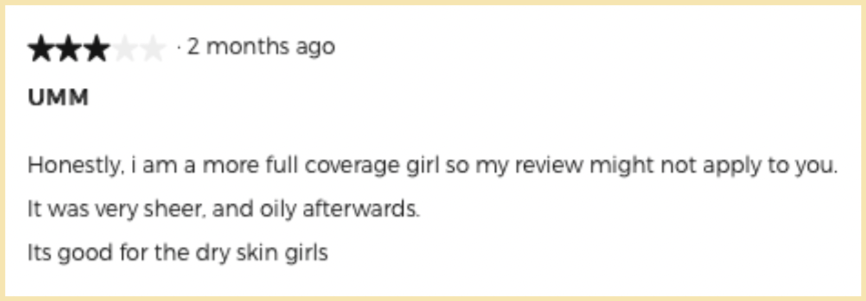
Source: Armani Beauty
Don’t let it attack the core features
Though it’s great to be transparent, alo takes it perhaps a bit too far – it attacks the core features of its product and causes all your uncertainties to ramp up. And what’s worse, there’s nothing positive to undo the damage.

Source: alo
4. Display data
This one’s all about the numbers: the number of customers served, the number of projects delivered, the number of champagne bottles drunk… (okay, maybe not that one, but you catch the drift). Basically, display data demonstrates that a single number can be worth a thousand words. It shows that your business is seasoned and you know what you’re doing since you’ve worked with so many people before.
Combine this type of social proof with other types like (case studies, reviews, etc.) – so that you’re not just saying “X people bought our product or service” but also “this is how much they’re loving it.”
Combine this type of social proof with other types like (case studies, reviews, etc.) – so that you’re not just saying “X people bought our product or service” but also “this is how much they’re loving it.”
Buffer relies on a “customers-served” style of social proof in order to boost up conversions, along with some other numbers such as the number of blog readers and social followers.

Source: CXL
5. Existing customers’ and clients’ logos
Showing that you’ve worked with some well-known brands is a great form of social proof. So if you’ve served some big-name clients, be sure to include that information and their logos on your homepage.
Or, if big names use your product, you can take the Biteable route – Biteable features a “Used by” section highlighting the big, well-known brands that people know and trust.

Source: Biteable
There’s just one caveat, however: these logos are now on nearly every single website you visit. It’s likely that visitors to your site are so used to seeing them that this technique is beginning to suffer from BBS, or “Banner Blindness Syndrome.” Showing these logos certainly won’t hurt your case or make things worse, but it also won’t score you any points, either, especially if you’re trying to persuade visitors to take you up on your offer.
People also don’t tend to recall client logos in the same way. According to research conducted by the CXL Institute, page visitors recalled high-profile client logos more than low-profile logos.
High-profile client logos are likely the best social proof to have, as they balance high recall with low cognitive load. But they’re not easy to get. If you don’t have any, testimonials with photos might be worth more than low-profile logos.
They conclude that: “High-profile client logos are likely the best social proof to have, as they balance high recall with low cognitive load. But they’re not easy to get. They recommend that ”If you don’t have any, testimonials with photos might be worth more than low-profile logos.”
Now let’s take a look at 3 businesses who haven’t used any of the standard forms of social proof mentioned above.
Social proof in business
Reducing insurance fraud
One insurance company wanted to see whether they could reduce dishonesty in their insurance claims and decrease opportunistic insurance fraud.
Opportunistic insurance fraud occurs when otherwise law-abiding citizens submit false or exaggerated information on an insurance application or claim forms in order to get a better deal for themselves. With insurance, this means paying a lower premium or receiving a higher payout (more money).
Opportunistic insurance fraud occurs when otherwise law-abiding citizens submit false or exaggerated information on an insurance application or claim forms in order to get a better deal for themselves.
This type of fraud can take on quite a few different forms and can have quite a few different motivations – it’s a complex behavior.
The 2 questions addressed by Dectech, the research team that the company hired to tackle this problem, were:
- Can we incorporate messaging into communications in order to reduce instances of opportunistic insurance fraud, and how effective can this be?
- Can these messages and interventions be developed without negatively impacting consumers’ perceptions of the insurance provider?
They tested out 18 different messages for both applications and claimed to see which message prevented dishonesty the best. Performance for each individual intervention varied, with the very best of the bunch (the social norm message from above) having an impact in excess of 70% of dishonesty cases curbed.
Social norms message: “Did you know that 95% of insurance customers fill in their forms fairly and accurately, and make honest insurance claims – be one of them.”
It was vital that Dectech displayed their social norm messaging right before people answered crucial questions. Had it been placed at the beginning or at the end of filling out the form, it might’ve had a much smaller impact. So remember, sometimes the timing of WHEN the customer sees your message is more important than the content of the message itself.
The same goes for messages on your landing product page – use social proof to support the argument you’re making and the story of the product you’re telling with the rest of the landing page. Place social proof as supporting copy near a call to action (CTA) or at a point of friction.
Increasing one job portal’s conversion rate
Is it possible to boost job ad conversions without changing a single word in the job ad? As it turns out, yes. Yes, it is. It can actually be a piece of cake when you have a proper understanding of social proof. With the help of behavioral experts from Mindworx, they dove deeper into the mindset of the average job seeker.
In the end, they tried something that, at first glance, defied all logic but proved to work. It was showing job-seekers how many people have already applied for the position they’re looking at! They ran the test for several weeks and were shocked by the results.
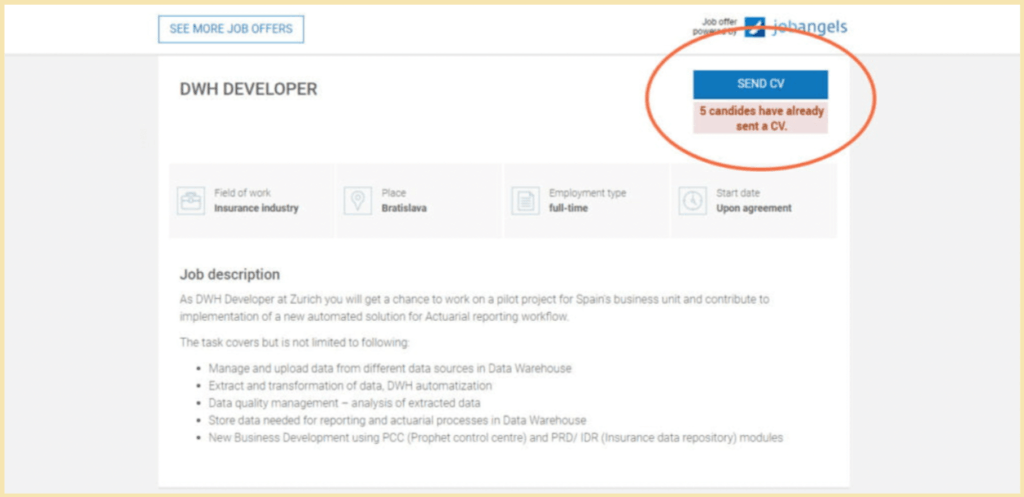
Source: InsideBE
The number of jobseekers sending in their CVs after this form of social proof was introduced soared by 138%!
It might seem a bit counterintuitive. Why tell a job seeker that a whole crowd of people have already beaten them to the chase? But it turns out that in similar situations of uncertainty, people tend to look to others to see what the right course of action is. The more people that applied for the job, the more attractive the posting was.
But it turns out that in similar situations of uncertainty, people tend to look to others to see what the right course of action is. The more people that applied for the job, the more attractive the posting was.
Freeing up the phone lines for the most vulnerable
Social proof might also be used as a way of adding friction/reassurance to steer people away and direct them towards the “right” course of action. For Standard Life, this meant directing people to other channels of communication in order to interact with the company.
Friction
Everything along the customer’s journey, which is objectively a little harder than it should be. it needs to be removed to elicit a desired behavior or response.
During the onset of the 2020 pandemic, Standard Life – one of the UK’s top insurance companies – became inundated with phone calls. So they made an active effort to keep the phone lines free for its most vulnerable customers (seniors, disabled customers) and steered people away from picking up the phone as their primary option for resolving their queries.
Standard Life encouraged more customers to use digital services with the help of simple changes in language. Though it’s true that in the pension industry, one can’t use social norms to push forward a certain product, they can, however, use it to push forward a type of service.
The message, which combined social proof with present bias, was: “More and more customers get more up-to-date information now by looking through frequently asked questions or via a web chat. This leaves the lines free for people who are in potentially more vulnerable situations and NHS workers who are working long shifts during the day.”
Social proof in public policy
Tax collection
We’ve seen social proof work in commercial settings, but could it be of any help to public service? It turns out it can! The UK Debt Management and Banking Team teamed up with the Behavioral Insights Team to see if they could use social norms to encourage people to pay their tax debts more quickly.
Let’s say, for example, you lived in London. Would you be more likely to pay your tax debts if you learned that most Londoners had already paid theirs?
The two joint teams tested out three different messages featuring different social norms. They sent out letters to 140,000 UK taxpayers. All of the social norm letters included the statement that “9 out of 10 people in Britain pay their tax on time.”

In two experimental groups, the letter also included information that most people, either in the recipient’s local area, town, or postcode, had already paid their taxes.
It turns out that the information on the social norms of a particular town gave the most impressive results. That’s what we call a 15% increase from the standard (no social norm), which led to over £9.1m in extra revenue in the first 23 days.
If you’re fascinated by the power of social proof, watch this video to learn more.
Household recycling
605 households in California participated in a study to see whether they would recycle more if they were exposed to different appeals. Households were randomly assigned to 5 different conditions. Some received just a door hanger featuring a universal plea (the same for all groups) while others received that same universal plea plus an additional, specific message.
The universal plea was: “Your household has been selected to volunteer in a study on recycling. Please, try to recycle as much as possible.”
Over the course of four weeks, the first group received only this plea.
The second group received a plea plus individual feedback – every week, they received feedback on how much they had recycled in the previous week.
The third group received the same door hanger as the second group, but instead of individual feedback, they received group feedback informing them of recycling trends in their residential area (no comparisons provided).
The fourth group received 4 door hangers describing various information on recycling (such as what to recycle and what not to recycle and how recycling works…)
The takeaway was that the information-only and plea-only conditions had no substantial effect on recycling behavior. However, the individual and group feedback both saw a significant increase in recycling.
And finally, the fifth group – the control group – received nothing.
The takeaway was that the information-only and plea-only conditions had no substantial effect on recycling behavior. However, the individual and group feedback both saw a significant increase in recycling.
The participation rate for the group that received individual feedback increased from 5% to 24%; while under the group-feedback conditions, the participation rate increased from 5% to 13%. However, it’s fair to say that in both of these groups, a boomerang effect was observed: households in the top third cut back on their recycling.
The follow-up question is: how can we deal with this boomerang effect? To answer this, researchers also tried sending letters that included a second piece of information: an “injunctive norm”, or message that indicates social approval or disapproval.
If households were consuming less energy than the average, they got a smiley face; and if they were consuming more energy than the average, they got a sad face. While the addition of a cartoon smiley face might seem like a trivial thing, it was effective in changing people’s behavior: the boomerang effect disappeared when people also received an injunctive norm.
This just goes to show that the weight of social approval is a powerful thing.
Social proof in non-profit organizations
When considering making a donation to a noteworthy cause, the first question that comes to mind is probably, “How much should I give?” More times than not you’re unsure, and so you’ll look at what others have already pitched in.
Negative Social Proof
Be careful about negative social proof. If you want people to do something, don’t tell them that the majority isn’t doing it.
So if you run a charity, you should be mindful of this – make sure you’re not using social proof that anchors a low number as a reference point for prospective donors. If your goal is to get the average person to donate 50 dollars, showing that the majority of people contributed 25 dollars will likely make more people stick to that sum. This means it might lower donations from donors who would have sent more.
Social proof can be tricky at the start of a campaign when numbers are low. If that’s the case, don’t broadcast them, it might trigger negative social proof. Instead, lean into qualitative social proof, which is a more personal form of social proof.
Social proof can be tricky at the start of a campaign when numbers are low. If that’s the case, don’t broadcast them, it might trigger negative social proof. Instead, lean into qualitative social proof, which is a more personal form of social proof.
Post a few short testimonials from diverse donors and identify them as such. Photos and real names increase the credibility of this kind of appeal as it becomes a more personal form of social proof.
Water: display live donations
Live donations on your website give visitors a sense of trust and positive sentiment. Sites with these kinds of social proof pop-ups get more conversions, or donations, compared to websites with no live conversions displayed. The live notifications also help in creating a sense of “business” on your website, which adds to the potential donor’s contribution decision.
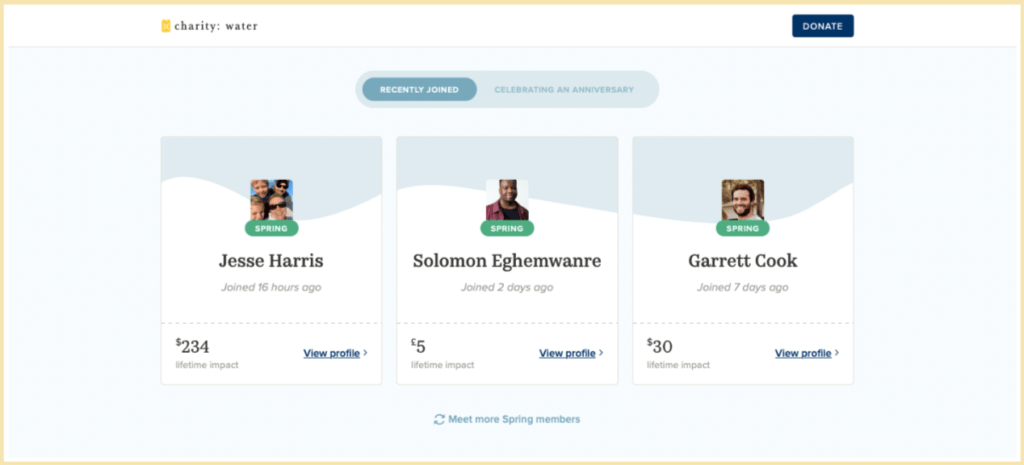
Source: charity: water
If you have the numbers, be sure to lean into them.
This is social proof in its most basic form using the number of projects funded and people impacted — and tying it back to the support of donors.

Source: charity: water
Display a goal bar
Another way to help raise more money – and show that many people have already supported your cause – is a goal progress bar. It combines social proof with the goal gradient effect, in which people’s motivation increases the closer they get to achieving a goal.
Goal Gradient Effect
Make your customers feel they’ve already made progress towards a goal. It’ll help them get started and it will increase the likelihood of completing the goal.
You can leverage both of these heuristics if you display how close you are to achieving your goal and how much money other people have already given.
With that being said, the point in which you choose to display this matters – if it’s early on and there’s just a little bit of money raised, it might deter people from donating (read more about negative social proof). Also, if you’ve already met your “goals”, showing the progress goal bar might also have the opposite effect: incorrectly ensuring more people that the right way is to NOT donate.

Source: Give WP
Examples of when social proof backfired
Social proof is not a cure-all. The pioneering work of Solomon Asch in the early 50s showed that 25% of people never conformed! And there’s more research to back this up.
People who were told that an older peer had made certain choices were more likely to follow their lead, but only when it came to choosing certain products!
John Berger, a social psychologist, ran experiments to see what factors influence whether we rely on social proof to inform ourselves and to determine when we don’t act on it. It turns out that the reference group and the type of choice we make plays a role too.
Berger asked participants to choose from various consumer products (paper towels, clothes, laundry detergents, and music). Half of the group was told what product a different participant (someone who was a couple of years older than them) had already picked.
People who were told that an older peer had made certain choices were more likely to follow their lead, but only when it came to choosing certain products!
The opposite was true when it came to making decisions on music and clothes – they were less likely to pick the same options as the older person. This shows that, at times, our desire not to be like someone else prevails (for instance, when we think that “that someone else” is lame or has terrible taste).
So now that you know why you roll your eyes when your dad blasts “Islands in the Stream” in the car, let’s look at other instances where social proof failed and was actually detrimental to the bottom line.
Charitable donations
You’ve read about ways in which social proof can help with donations, but here’s a case where using social proof had the exact opposite effect.
Every year, there’s a charity campaign in Slovakia called Daffodil Day. It’s when thousands of volunteers go out on the streets to raise money for cancer patients. One prominent telco operator offered to send free fundraising texts to tens of thousands of its clients. In order to donate, all they had to do was reply with a blank message.
Mindworx, a behavioral consulting firm, crafted and tested multiple text messages using various behavioral economics principles to nudge more people to donate.
There was one winning message that ended up increasing conversions by 55%. However, the other two messages that relied on social proof performed worse than the control one!
They read as follows:
“Thousands of people will participate in Daffodil Day this year. Become a donor and send a blank text message worth 2 EUR to 848. Thank you! – The League Aginst Cancer and O2.”
“Join thousands of O2 customers who will support this year’s Daffodil Day. Send a blank text message worth 2 EUR to 848. Thank you! – The League Aginst Cancer and O2.”
One possible explanation was that people were falsely reassured by social proof; by seeing that a lot of other people have already donated, they might not have felt so compelled to do so themselves. They might’ve even thought: “Looks like they’ve already got enough donations, they don’t need me to pitch in.”
With that being said, there was a message that made telco customers open up their hearts, (or at least, their wallets). You can read how it went here. To learn more about how to use (and not use) social proof in charitable donations, check out this article.
KFC’s one-dollar french fries deal
A few years back, KFC asked Ogilvy’s team of experts to increase the intangible value around one of their products: $1.00 french fries. This was their annual campaign that had already been rolled out in Australia a few times before.
Was there still something that could be done to give it a significant boost? As it turns out, yes, and Ogilvy came up with 5 solutions, 4 of which performed better than the original campaign. Learn here what those were and why they worked so well.
But there was one solution that underperformed. Unsurprisingly, it was a social norm message.
It read: “Everyone’s enjoying our french fries for $1, why not you?”, encouraging people to follow a specific action many others find irresistible.
Behavioral science isn’t a silver bullet. But by testing and learning, we can understand what strategies are most effective and we can replicate and scale that accordingly.
The rate of unique clicks on sponsored social media posts were used as a proxy to access message potency. But alas, this social norm message went backwards from the control.
The team’s hypothesis is that unlike with other messages, this one may have felt like advertising and people could smell that, and so it may have had an adverse effect on their willingness to purchase the french fries.
This illustrates an important point. Behavioral science isn’t a silver bullet. But by testing and learning, we can understand what strategies are most effective and we can replicate and scale that accordingly.
Summary
What is social proof?
Social proof is the idea that people copy the actions of others in an attempt to emulate the “correct” behavior in certain situations. Essentially, it’s borrowing third-party influence wisdom from the crowd in order to sway potential customers.
How to use social proof:
- Content matters. Social proof works best when people are uncertain (they’re more likely look to others for cues and clues). To harness it, first identify the uncertainties that customers have and then nip them in the bud with the help of testimonials or other forms of social proof.
- Relevance matters. Not everyone’s actions are enough to sway other people. Social proof is most effective when the reference group is as relatable to your customers as possible.
- Placement matters. Use social proof as supporting copy near a CTA or at a point of friction.
How to NOT use social proof:
- General praise won’t help to convince prospective customers. Your testimonials need to counter actual uncertainties and NOT just praise your product or counter non-existent objections. Use testimonials that address uncertainties, that talk about the benefits of yoru product or service, and that use your business’s keywords.
- If you rely on percentages to make your argument stronger, DON’T just say what many people do, but rather what the MAJORITY does.
- Be careful about negative social proof. If you want people to do something, don‘t tell them that the majority of people aren’t doing it.
Additional resources:
1. Social Proof: Influencing Decisions of Your Customers | R Interactives

